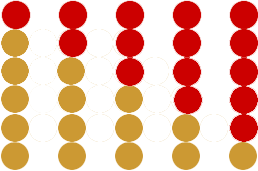 |
 |
| Name: Stuart Who is asking: Other Level of the question: All Question: Hello there!! Ok, so i am collecting 50p pieces and arranging them on my desk in the shape of a triangle. I want to work out how much money I'm saving just by knowing how many rows of coins there are. If i can work out how many coins there are just by knowing how many rows I have I can just divide by 2 to find out the amount in dollars. Cheers Stuart
|
|
Stuart, If you have 1 row there is a total of 1 coin. These numbers 1, 3, 6, 10,··· are called triangular numbers. Suppose you have 5 rows of 50p pieces.
Slide the top 4 rows to the left to form a triangle with a right angle at the lower left corner.
What you have now is a rectangular array of coins with 6 rows and 5 columns and hence 6
The same construction works for any row. If you have a triangle of n rows of 50p pieces then you have a total of
Penny |
 |
 |
 |


